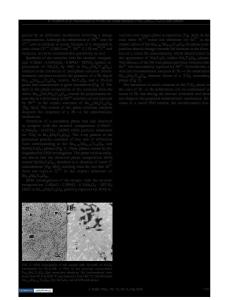Structure Determination of Ba 8 CoRh 6 O 21 , a New Member of the 2H-Perovskite Related Oxides
- PDF / 325,198 Bytes
- 7 Pages / 612 x 792 pts (letter) Page_size
- 36 Downloads / 274 Views
Structure Determination of Ba8CoRh6O21, a New Member of the 2H-Perovskite Related Oxides H.-C. zur Loye*, M. D. Smith, K. E. Stitzer Department of Chemistry and Biochemistry, University of South Carolina, Columbia, SC, 29208, USA, email: [email protected] ✝
A. El Abed and J. Darriet Institut de Chimie de la Matière Condensée de Bordeaux (ICMCB-CNRS), Avenue du Dr. Schweitzer, 33608 Pessac Cedex, France ✝ Permanent Address: Mohamed I Univ., Facultédes Sciences, Oujda, Morocco. ABSTRACT Single crystals of Ba8CoRh6O 21 were grown out of a potassium carbonate flux. The structure was solved by a general method using the superspace group approach. The superspace group employed was R 3 m(00γ)0s with a = 10.0431(1) Å, c1 = 2.5946(1) Å and c2 = 4.5405(1) Å, V = 226.60(1) Å3. Ba8CoRh6O 21 represents the first example of an m = 5, n = 3 member of the A3n+3mA’nB3m+nO9m+6n family of 2H hexagonal perovskite related oxides and contains chains consisting of six consecutive RhO6 octahedra followed by one distorted CoO6 trigonal prism. These chains in turn are separated from each other by [Ba]∞ chains. INTRODUCTION Low-dimensional magnetic systems have attracted much interest historically due to the presence of magnetic behavior unique to structurally highly anisotropic systems. [1-3] Insights into such behavior can be gained from structural families where it is possible to systematically vary either the structure or the composition independently. For this reason, perovskite and perovskite-related oxides in particular have long provided excellent candidates for structural and physical property studies, due to the compositional and structural flexibility of this huge extended oxide family. Recently, much interest has been focussed on a large and varied group of oxides closely akin to the pseudo-one-dimensional 2H hexagonal perovskites, with the general formula A3n+3mA’nB3m+nO9m+6n (n, m = integers, A = alkaline earth; A’, B = large assortment of metals including alkali, alkaline earth, transition, main group and rare earth metals). [4-25] An early general structural classification of these materials based on the filling of interstitial sites generated by the stacking of [A3O9] and [A3A’O6] layers was developed by Darriet and Subramanian. [26-27] This approach easily describes the structural composition of all the commensurate members of this family of structures and can be extended to encompass members that form incommensurately modulated (aperiodic) structures. An alternate, complementary description that highlights the low-dimensional nature of these compounds is the composite structure approach. In this structural description, these oxides consist of two crystallographically independent sub-structures, [A]∞ chains and [(A’,B)O3 ]∞ columns made up of distinct ratios of face-sharing octahedra and trigonal prisms. In many cases, the ratio of the repeat distances of the two chains is not a rational number and, consequently, the structure is incommensurately modulated along the chain direction. As shown previously, a better structural for
Data Loading...











